Two countries I didn’t envisage seeing when I set out from the UK was Mali and Burkina Faso. Like nearly every other cycle tourist in West Africa, I was going to follow the coastal route through many of the smaller West African countries. Guinea Conakry, Sierria Leone, Liberia, Ivory Coast etc.
Ebola and its repercussions had changed my plans as mentioned in earlier posts affording me the opportunity to see countries I hadn’t expected, countries that the government travel advice websites say to either completely avoid or be vary wary of certain areas.
Mali, desperately needs tourism, before the coup in 2012 and problems in the North where France is currently fighting against rebels, there was a small amount of tourism to places like Djenne where the worlds biggest mosque built from mud is situated. As soon as the troubles started this tourism virtually ceased and NGO’s (Non Government Organisations) were pulled out of the country.
Bamako is the capital of Mali and it’s where we headed to stop at the Sleeping Camel Auberge, a well known overland stop, somewhere to rest or base yourself to obtain visa’s needed further on in the travel.
Coming into Bamako the traffic increases, as does the dust and for the first time in a long while some extra effort is required as there are hills to contend with. West Africa so far has been mainly flat, no point in entering any of the Strava climbing challenges so far.
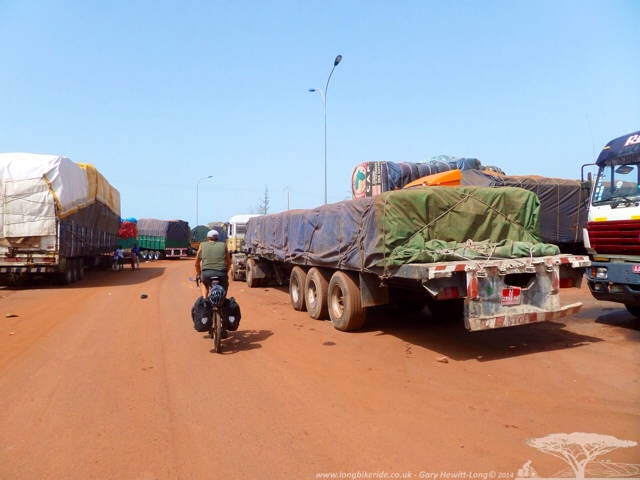
Cycling into Bamako through the Lorries
Bamako is an extremely busy city, many lorries on the outskirts trying to get in. I’m reminded I don’t like riding in cities as Wouter and I cross one of the two main bridges that spans the river Niger which cuts through the city. Motos or scooters pass by very close weaving in and out of traffic with scant regard to anyone’s safety, not even their own. The dust is thrown up from the roads as they go buy, making the eyes and throat sore. I feel safer to ride down the centre of the road away from the moto’s who by and large stick to the inside moto lanes that the cyclists should also use. But just over the bridge and a turn to the left takes us out of the main traffic, past the heavily fortified German Embassy and another left saw us at the Gates of the Sleeping Camel.
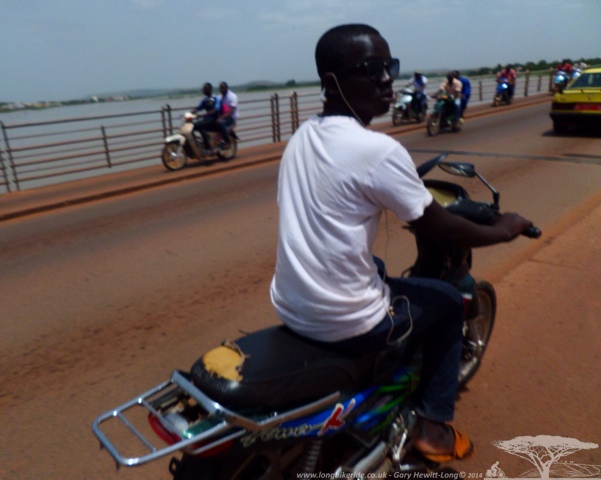
Moto’s passing close in Bamako
The sleeping camel has many interesting people staying there. Nicko from South Africa and Steve from Australia, who are helping along with several other team members of UNMAS to clear Mali of weapons and unexploded landmines. Dene who works with NGO’s in both Tanzania and Zimbabwe, Roo who’s off to do a placement in one of the villages in Dogan country, part of her new job is measuring locals. Graham who’s just finished his Peacecorp posting in Benin, riding a motorcycle to Europe. The bike caused him lots of problems so he ditched it in favour of public transport. Phil and Patrice who manage and run the camel and John from Portsmouth, England who arrived on a KTM 950, a beast of a motorbike.
We had one night out in town with several of the guests and got to see Bamako in another light. I had some sort of illness coming on but still wanted to go out, seeing some of Mali nightlife from another angle. The two clubs we visited could have been like any in the UK…. in the 1980’s or 90’s. Some of the music was the same from that era but everyone was enjoying themselves as well as the local people who were dancing the night away.
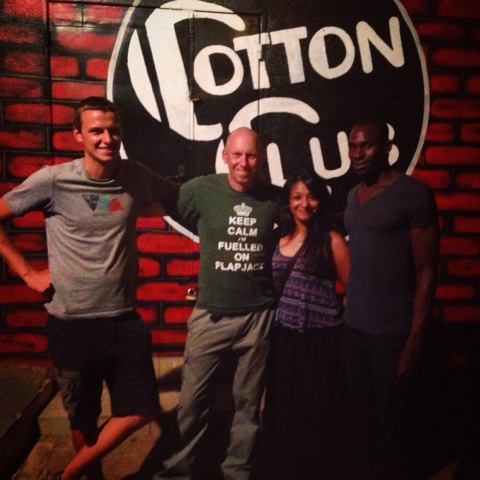
A night out at the Cotton Club in Bamako with Wouter and new friends from the Sleeping Camel
Throughout Africa, the most popular shirts worn by children and men are football t-shirts, many being UK or Spanish teams and by far the most seen UK team shirts are Chelsea, I can only presume there was a massive over run on Chelsea shirts when Abramovich took over, the surplus being dumped in Africa (I’m Gonna get some stick over this comment 🙂
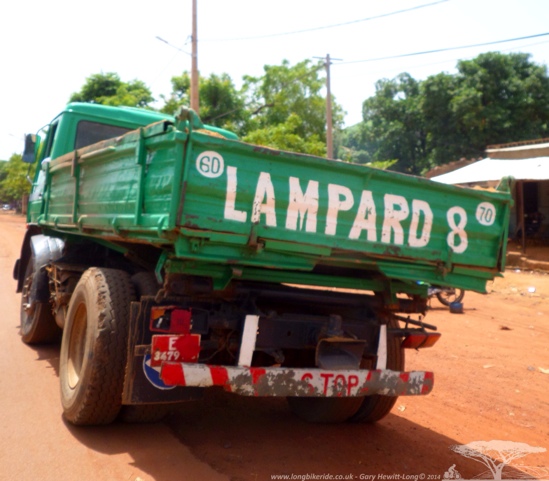
Chelsea Mad – The Whole of Africa
Some vehicles are even adorned with football related writing or drawings.
When explaining to people that I’m from England, many of the younger men and some of the older children ask which team I support. Funnily none of heard of either Chippenham Town or Swindon Town FC!
The side effects of Doxycycline continue to cause me sun sensitivity problems. I speak to many people at the Sleeping Camel who live and work in West Africa and many had experienced the same problems. The common theme with most long term travellers or workers in West Africa is to stop taking the anti malarial. They nearly all explain that the side effects of most and that to take a drug long term isn’t worth it, almost everyone suggested to buy and carry Coartem in the event of any malarial symptoms. In West Africa this drug is the most commonly prescribed course of treatment once a patient has Malaria kills the most common Malaria strains and it’s relatively cheap at 4,500 CFA per course (Just under £6). I’m still not sure, but have bought some to carry just in case. Doxycycline is still only 90% effective as an anti malarial, less effective than contraception is for pregnancy!
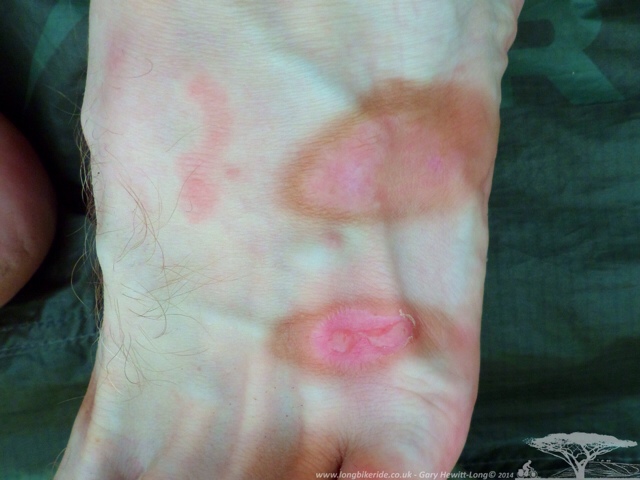
One Blister Bursts and there is another one.. It’s like Russian Dolls!
As a result of the continued sun sensitivity problems, I am coming up with new ways to protect my skin from the sun where I have problems. Mango leaves make an ideal disposable cover that slots into my cycling sandals.

Might not catch on… Mango Leaves as Sun Block
The stop also gives the chance to do some bike maintenance. The rear wheel loses pressure to 30 PSI over a couple of days but then stays at 30. So I hadn’t been overly worried. The stop gives a chance to see why. Taking off the rear tyre, there is a thorn and a piece of wire in the tyre, both had made very small holes in the tube. Taking off the front tyre as well and cleaning both tyres of embedded particles, they are then swapped around, the rear to the front and vice versa. With the rear carrying most of the weight, it is far more worn than the front, normal for a bicycle. Swapping them round at this point means they should both expire at about the same time. The signs of wear are still lower than I would expect after almost 7,000 miles, I am very impressed with the Schwalbe tyres.
Leaving Bamako, the traffic is worse than coming in, Moto’s seem to race by like angry bees. There had been rain, this mixed with sand and mud in the moto/cycle lanes makes cycling treacherous and it’s not long before something happens. I’m confronted with slippery mud, a small gap and a moto coming up behind me. I try to negotiate the mud as its the lesser of two evils, mud or put myself in the way of a speeding moto. It fails and the front wheel starts to slip, riding unclipped I am able to get my feet down quickly, just as the moto screeches to a halt next to me and my leg briefly touches the hot exhaust. Full of adrenaline it feels like a small scratch and we continue. The feeling changes quickly to one of a burn and luckily a shop is nearby to buy filtered water so I can quickly cool the burn.

Healing Nicely after touching a Moto Exhaust pipe.
Once a short way out of the city, the traffic soon eases and the cycling becomes more enjoyable.
Stopping for a brief rest at a roadside shop and whilst dozing on a bench, I hear a voice I recognise. It’s Albrecht again, great to see him again. Albrecht left Camping 7 in Senegal before Wouter and I did but is travelling at a much more leisurely pace, he was driving to Koudougou and then onto Djenne and Mopti with a local guide. Its the second time we have bumped into each other whilst we are on the road since leaving the North of Senegal.
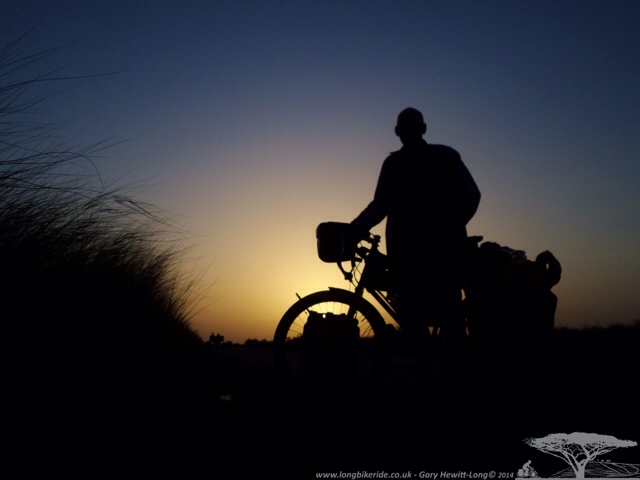
Me and my Bike at Sunset.
Segou heading North East from Bamako is another small city on the route toward Burkina Faso and lies next to the river Niger. The entry to Segou is a stark contrast to entering Bamako. There are tree lined streets which remind you of French Boulevards, a left over from French colonisation. Traffic is not rushing around dangerously and yet it is market day, the busiest day of the week. Entering the market area is hectic and trying to negotiate a loaded tourer through the crowds and stalls is nigh on impossible.
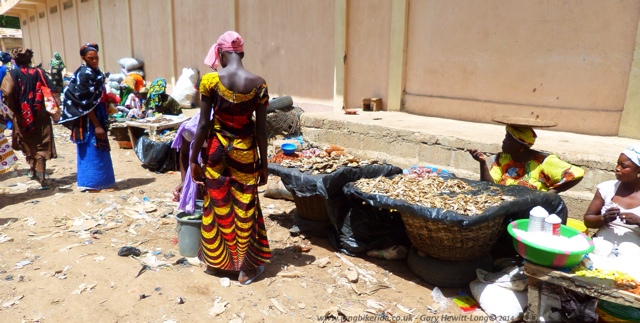
Segou Market, lots of new smells and sounds
Eventually making it to a quieter area we are approached by a Senegalese man who tells us there is a Spanish lady living up the road that takes guests so we head there and decide on an early stop. It affords Wouter the opportunity to take some good photos of an interesting area.
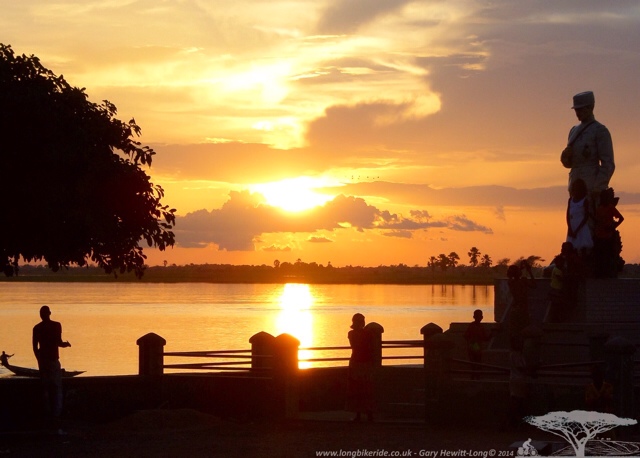
Watching the sun go down in Segou, Mali
The house we stop at is right by the river. As the sun starts to set, people come out by the river to watch. The colours are amazing and the view spectacular with fishermen checking their nets and children standing on the statue of the French Colonel Louis Archinard.
Leaving Segou the route continues toward Burkina Faso and the border at Benena. Wouter and I decide to go separate ways for a while before we meet back up in Ouagadougou. Wouter heads to Djenne whilst I continue a more direct route into and across Burkina. The last bit of road in Mali that are marked as paved on the map turn to dirt roads for 20 miles, but approaching the border to Burkina Faso, there is tarmac… good Tarmac, I mean tarmac without potholes!
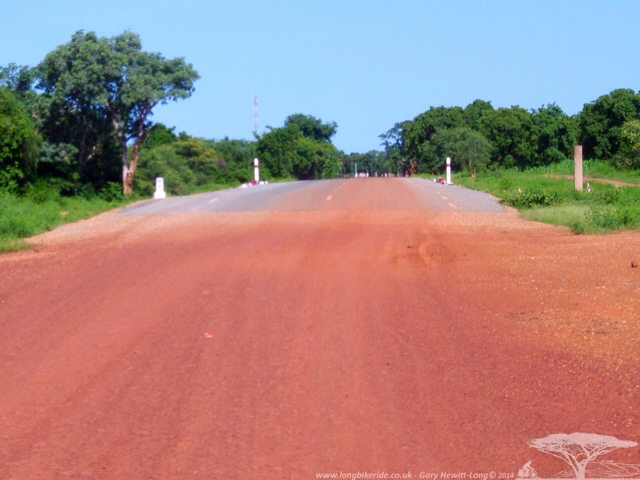
Coming into Burkina, Good Roads
Pulling up at the border post the officials are dressed very smartly and have a nice clean office and building, the most professional looking outfit since entering Africa. The officials smile and welcome me to Burkina and then check my visa, alls fine but I need a test… for Ebola. Although there have been no positive cases in Mali, it’s good to see precautions being taken at even this remote border. Pointing a temperature gauge at my forehead I am quickly told “C’est Bon!” it’s good!, a relief as I felt like I had a cold coming and my burn on my leg was slightly infected and leaking pus, my temperature was fine though.
The roads continue to be of a better quality and other things change, greeting people with the Bambara greeting of Anchay in the most part doesn’t get a reaction. Asking at a roadside food stall if there is Bambara here I am told that Burkina is a mix of ethnic groups.
There are more people on bicycles and less donkeys pulling carts but more horses with their carts having been brightly painted, larger and with sides.
Bikes are used to carry everything, other bikes and even trees. some carry goats, others carry pigs and chickens as I cycle along the good tarmac the list of things carried on bikes that you would not think possible increases.
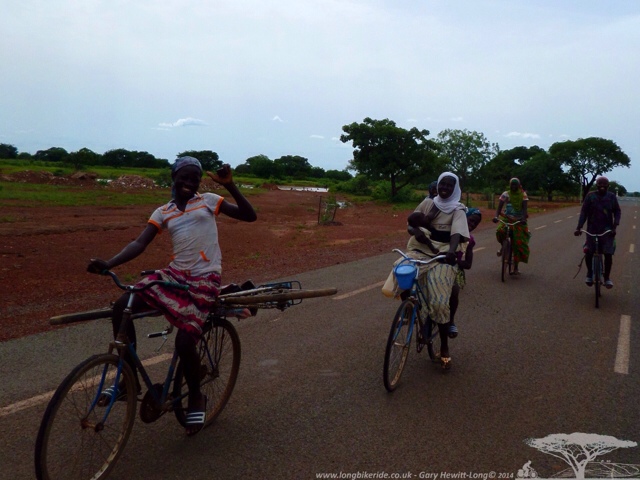
Ladies on bikes in Burkina
Some villages in East Mali and Burkina that are Islamic have mosques constructed of mud, some of these are spectacular to see.
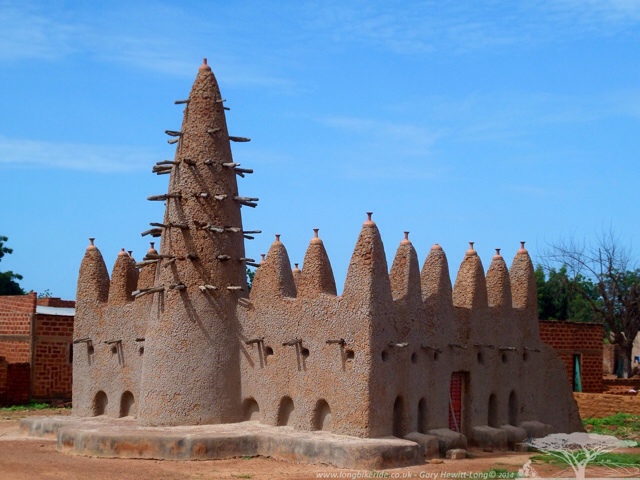
A Burkinabè Mosque made of mud
The water pumps also change from village to village, most villages have a pump in Burkina and they vary in type. A new type only seen in Burkina so far has a big flywheel making the job of pumping water much easier once the initial inertia of the wheel is started.
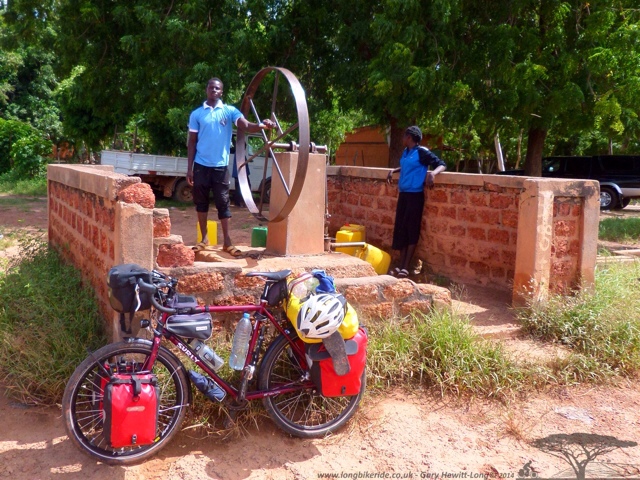
A flywheel water pump in Burkina Faso
During a welcome warm showers stop in Koudougou with a Peacecorp volunteer Ethan, we go for a pizza and meet several other workers. They are all posted to different villages and sign up for two years initially. They run various projects and help out in the villages. Its an admirable thing to do, the salary is low around $200 a month and to go from a western environment to a remote village with most living in local accommodation which could be a mud hut for two years is a massive and a very brave commitment.
Leaving Koudougou the smell of proper coffee entices me into a cafe, La Presse. I don’t need to rush as the distance isn’t far to Ouagadougou where I am flying to Nairobi and the Coffee and Food smell good. Talking to the owner in Franglais, we manage to communicate and he is fascinated by my ride and wants a picture together with my bike.
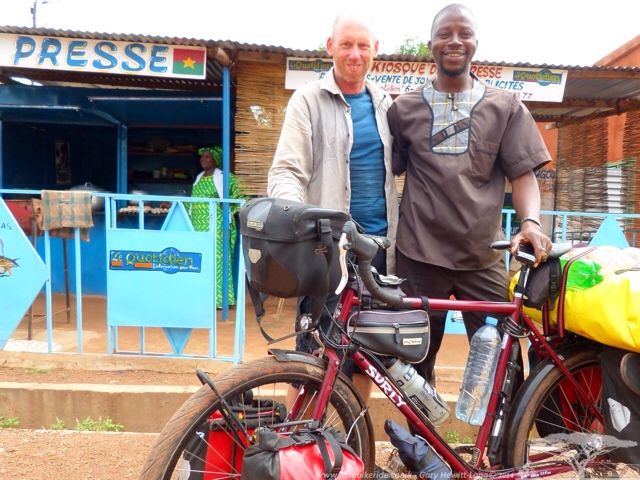
La Presse Cafe, good coffee and food in Koudougou, Burkina Faso
The food they serve is tasty, buying fried rice dishes throughout West Africa is cheap and its full of carbohydrates, essential cycling fuel.
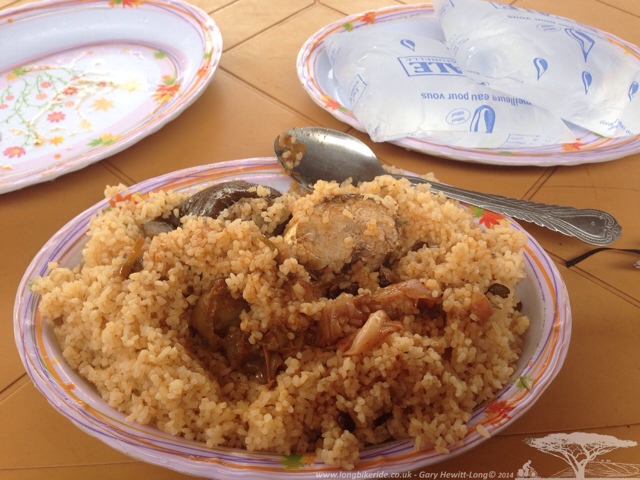
Fried Rice from La Presse Cafe in Burkina Faso
Wild camping is one of my favourite ways of stopping and resting overnight, finding a quiet place, putting up the tent and relaxing after cooking. I found an ideal spot off the the road, dry, slightly higher than its surrounding area so no flooding if it rained. The ground was clear. In the night I heard insects under my tent, just moving around, or so I thought. In the morning I packed up and to my surprise, the sheet I put under my tent wasn’t looking quite as good as when I put it down the previous night. It resembled a teabag. I had unwittingly placed the tent on an ants nest and they had decided to remove it. Luckily this cheap sheet took most of the ants attack, my tent ended up with about 5 small holes which I need to repair.
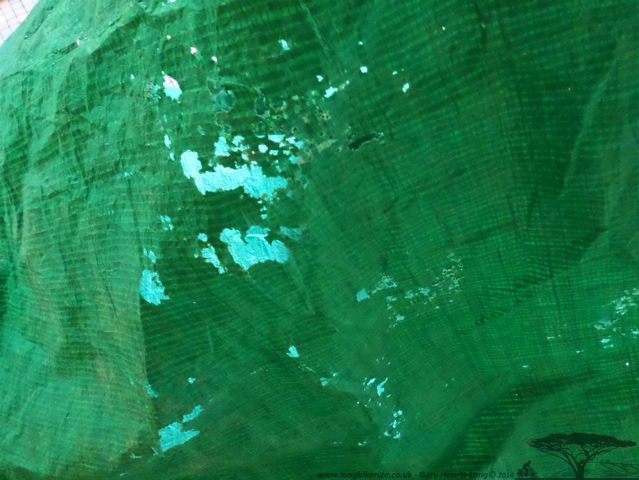
Darn, My £2.99 Mainly’s Tarp only lasted 4 Months, Dang Ants!
Oouagadougou, the capital of Burkina Faso and my next location was only about 45 miles away. Packing up early and making the most of the cloud cover I cycled slowly toward the city. Finding a nice spot with an interesting tree to stop after 10 miles to make some breakfast. Using up what I had in the bag I was able to make a rice pudding, with a little pasta to soak up excess milk, tasty and full of energy.
Whilst I am sat making breakfast an unusual site appears in front of me, a couple of men dressed in bright clothes, skin tight bright clothes, wearing helmets, cycling helmets and riding road bikes. The last ones I had seen were in The Gambia.
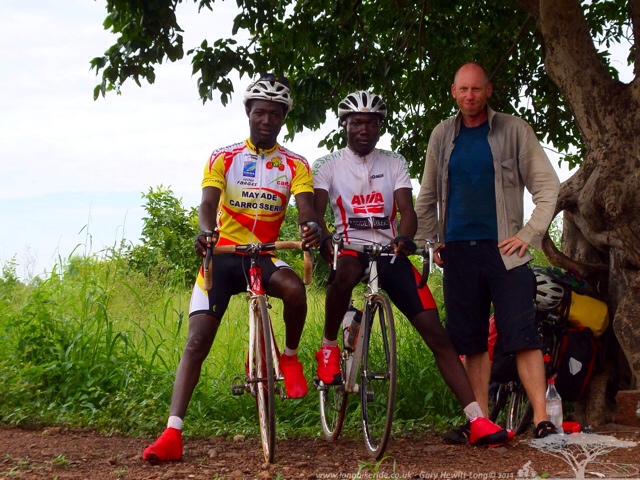
Issaka and his buddy riding road bikes in Burkina Faso
Issaka and his friend were out on a training ride and were equally shocked to see me, turning round in the road they came back to see me. They are surprised to hear I have cycled from England, I am surprised to hear that they are part of a cycling club, Velo Club RCK.
Riding into Ouagadougou, I was expecting the worst, more moto’s and crazy traffic. I needn’t have worried, although the motos treated the traffic lights as optional, the risks taken by riders were much less and the roads far less busy. Ouagadougou is a much cleaner and modern city in comparison to Dakar, Banjul or Bamako. Wide streets with more modern buildings. Lots of trees and statues, an upcoming city which looks to be modernising fast.
I stopped outside the Institut Geographique Du Burkina where they had a large outline of Burkina and the main towns plotted. My route from the West, Dedougou, Koudougou and Ouagadougou..push pineapple… shake a tree…
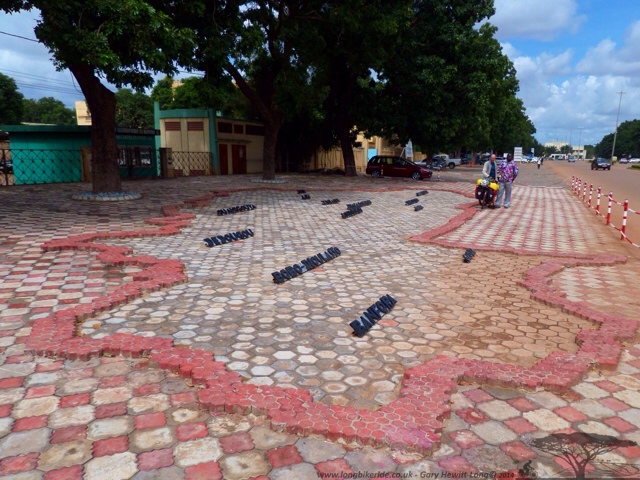
Map of Burkina in Ouagadougou, Burkina Faso
I am staying in Ougadougou with Giel and Wies a welcoming and warm Dutch couple living and working in Burkina Faso and members of Warm Showers, they have welcomed me into their home until my flight to Nairobi, somewhere I can also service my bike and kit before starting anew in the east.


